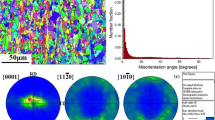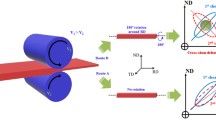Abstract
Present work describes a correlation between texture and sample orientation-based flow parameters of three different zircaloy-4 sheet materials. The three different sheet materials [slab route sheet (SRS), tube route sheet (TRS) and low-oxygen sheet (LOS)] corresponded to three different routes of fabrication and hence represented as variation in starting condition. All the three materials exhibited the presence of moderate texture. The intensity is more in TRS samples in comparison with that of the SRS and LOS. This in turn resulted in moderate values of anisotropy parameters. The strength parameters and elongation values have increased and decreased with increase in strain rate, respectively. The flow behavior of the alloys followed typical Holloman equation. The instantaneous work-hardening rate curves of the present alloys exhibited all the three typical regimes (i.e., regime I, regime II and regime III).
















Similar content being viewed by others
References
B. Lustman, Zirconium technology—twenty years of evolution, in Zirconium in the Nuclear Industry (ASTM International, West Conshohocken, 1979), pp. 5–14. https://doi.org/10.1520/stp36669s
S. Kass, The development of the zircaloys, in Corrosion of Zirconium Alloys (ASTM International, West Conshohocken, 1964), pp. 3–25. https://doi.org/10.1520/stp47070s
J.H. Eyler, Development and Control of the Process for the Manufacture of Zircaloy-4 Tubing for LWBR Fuel Rods (Bettis Atomic Power Lab., West Mifflin, 1981). https://doi.org/10.2172/6780381
D. Fuloria, N. Kumar, S. Goel, R. Jayaganthan, S. Jha, D. Srivastava, Tensile properties and microstructural evolution of Zircaloy-4 processed through rolling at different temperatures. Mater. Des. 103, 40–51 (2016). https://doi.org/10.1016/j.matdes.2016.04.052
E. Tenckhoff, Review of deformation mechanisms, texture, and mechanical anisotropy in zirconium and zirconium base alloys. J. ASTM Int. 2, 25–50 (2005). https://doi.org/10.1520/JAI12945
K.L. Murty, I. Charit, Texture development and anisotropic deformation of zircaloys. Prog. Nucl. Energy (2006). https://doi.org/10.1016/j.pnucene.2005.09.011
R.G. Ballinger, G.E. Lucas, R.M. Pelloux, The effect of plastic strain on the evolution of crystallographic texture in Zircaloy-2. J. Nucl. Mater. 126, 53–69 (1984). https://doi.org/10.1016/0022-3115(84)90532-4
M.J. Philippe, M. Serghat, P. Vanhoutte, C. Esling, Modeling of texture evolution for materials of hexagonal symmetry. 2. Application to zirconium and titanium alpha-alloys or near-alpha-alloys. Acta Metall. 43, 1619–1630 (1995). https://doi.org/10.1016/0956-7151(94)00329-g
R.A. Lebensohn, M.I. González, C.N. Tomé, A.A. Pochettino, 1.4. Mechanical behavior: measurement and prediction of texture development during a rolling sequence of Zircaloy-4 tubes. J. Nucl. Mater. 229, 57–64 (1996). https://doi.org/10.1016/0022-3115(95)00210-3
K.V.M. Krishna, S.K. Sahoo, I. Samajdar, S. Neogy, R. Tewari, D. Srivastava, G.K. Dey, G.H. Das, N. Saibaba, S. Banarjee, Microstructural and textural developments during Zircaloy-4 fuel tube fabrication. J. Nucl. Mater. 383, 78–85 (2008). https://doi.org/10.1016/j.jnucmat.2008.08.050
H. Akhiani, J.A. Szpunar, Effect of surface roughness on the texture and oxidation behavior of Zircaloy-4 cladding tube. Appl. Surf. Sci. 285, 832–839 (2013). https://doi.org/10.1016/j.apsusc.2013.08.137
P. Manda, U. Chakkingal, A.K. Singh, Effect of alloying elements in hot-rolled metastable β-titanium alloys. Part II: mechanical properties. Metall. Mater. Trans. A 47, 3447–3463 (2016). https://doi.org/10.1007/s11661-016-3508-5
G.E. Dieter, D.J. Bacon, Mechanical metallurgy. J. Frankl. Inst. 273, 338 (1962). https://doi.org/10.1016/S0016-0032(62)91145-6
K.V. Jata, A.K. Hopkins, R.J. Rioja, The anisotropy and texture of Al–Li alloys. Mater. Sci. Forum 217–222, 647–652 (1996). https://doi.org/10.4028/www.scientific.net/MSF.217-222.647
S. Banumathy, R.K. Mandal, A.K. Singh, Structure of orthorhombic martensitic phase in binary Ti–Nb alloys. J. Appl. Phys. 106, 93518 (2009). https://doi.org/10.1063/1.3255966
Y.T. Wu, C.H. Koo, Effects of texture on the superplasticity of Ti–25Al–10Nb alloy. Intermetallics 5, 29–36 (1997). https://doi.org/10.1016/S0966-9795(96)00062-3
G.E. Dieter, Mechanical Metallurgy (McGraw-Hill Book Co., Singapore, 1988)
C. Zener, J.H. Hollomon, Effect of strain rate upon plastic flow of steel. J. Appl. Phys. 15, 22–32 (1944). https://doi.org/10.1063/1.1707363
C. Mondal, A.K. Singh, A.K. Mukhopadhyay, K. Chattopadhyay, Tensile flow and work hardening behavior of hot cross-rolled AA7010 aluminum alloy sheets. Mater. Sci. Eng., A 577, 87–100 (2013). https://doi.org/10.1016/j.msea.2013.03.079
C. Keller, E. Hug, D. Chateigner, On the origin of the stress decrease for nickel polycrystals with few grains across the thickness. Mater. Sci. Eng., A 500, 207–215 (2009). https://doi.org/10.1016/j.msea.2008.09.054
Acknowledgements
The financial support received for this research work from Department of Atomic Energy, Government of India, 36(2)/14/56/2014-BRNS/2699 is gratefully acknowledged.
Author information
Authors and Affiliations
Corresponding author
Rights and permissions
About this article
Cite this article
Limbadri, K., Singh, S.K., Satyanarayana, K. et al. Orientation-Dependent Tensile Flow Behavior of Zircaloy-4 at Room Temperature. Metallogr. Microstruct. Anal. 7, 421–433 (2018). https://doi.org/10.1007/s13632-018-0463-0
Received:
Revised:
Accepted:
Published:
Issue Date:
DOI: https://doi.org/10.1007/s13632-018-0463-0




